Case Study: Research & Statistical Methods on Job Insecurity
VerifiedAdded on 2023/06/12
|10
|2605
|108
Case Study
AI Summary
This case study delves into the research and statistical methods employed to investigate the association between employee perceptions of job insecurity (both quantitative and qualitative) and their well-being, specifically job satisfaction and psychological distress, within the Belgian banking sector. The study, based on a cross-sectional survey of 15,000 employees from 63 banks, utilizes simple random sampling to ensure a representative sample. The research design is descriptive, aiming to explain the demographics of the participants and how variables influence each other. The paper addresses key aspects of the research process, including sample size determination, sampling methods, measures of variables, data collection on social demographics, and the overall research design, ultimately providing insights into the complexities of business research and statistical analysis.
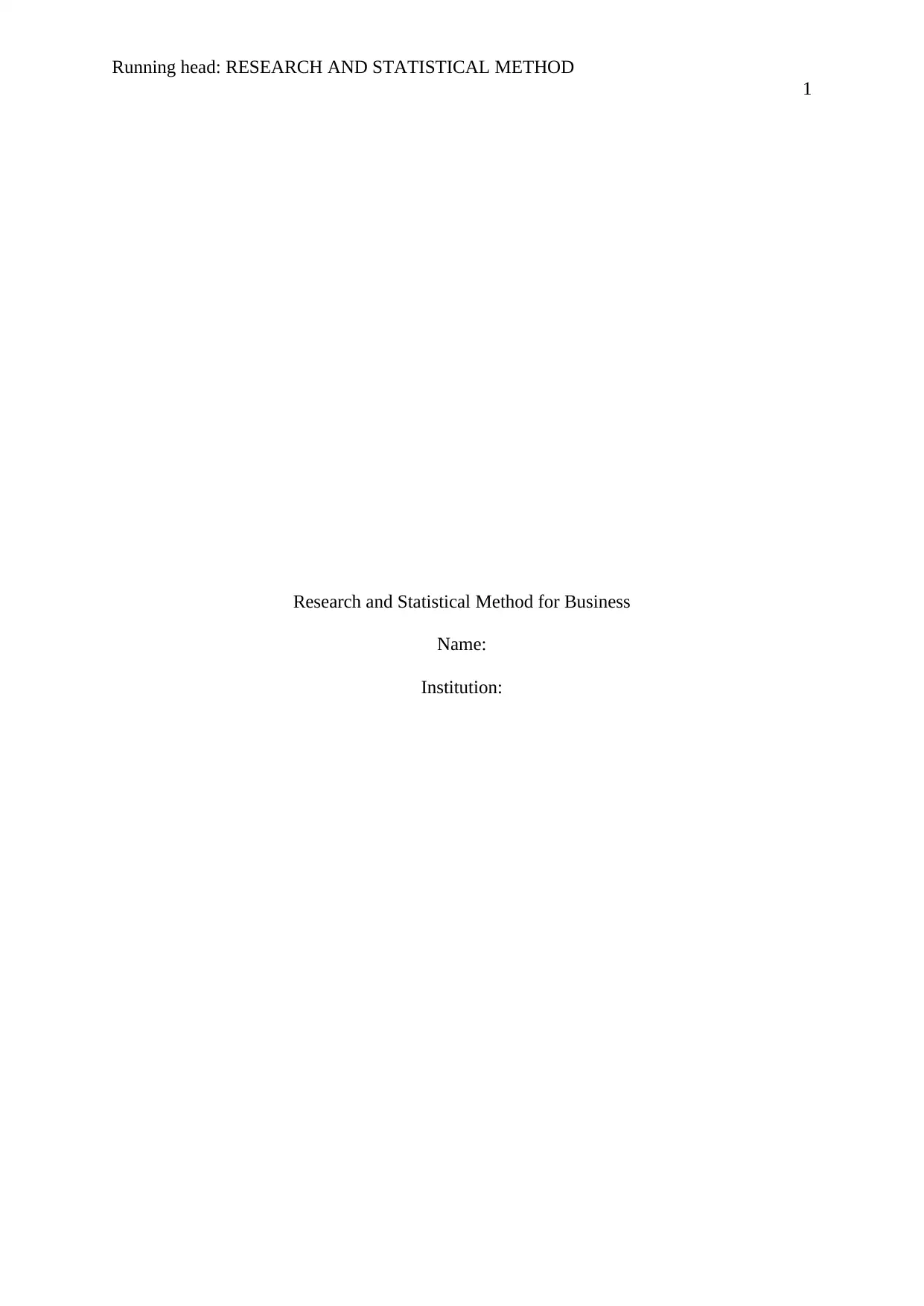
Running head: RESEARCH AND STATISTICAL METHOD
1
Research and Statistical Method for Business
Name:
Institution:
1
Research and Statistical Method for Business
Name:
Institution:
Paraphrase This Document
Need a fresh take? Get an instant paraphrase of this document with our AI Paraphraser
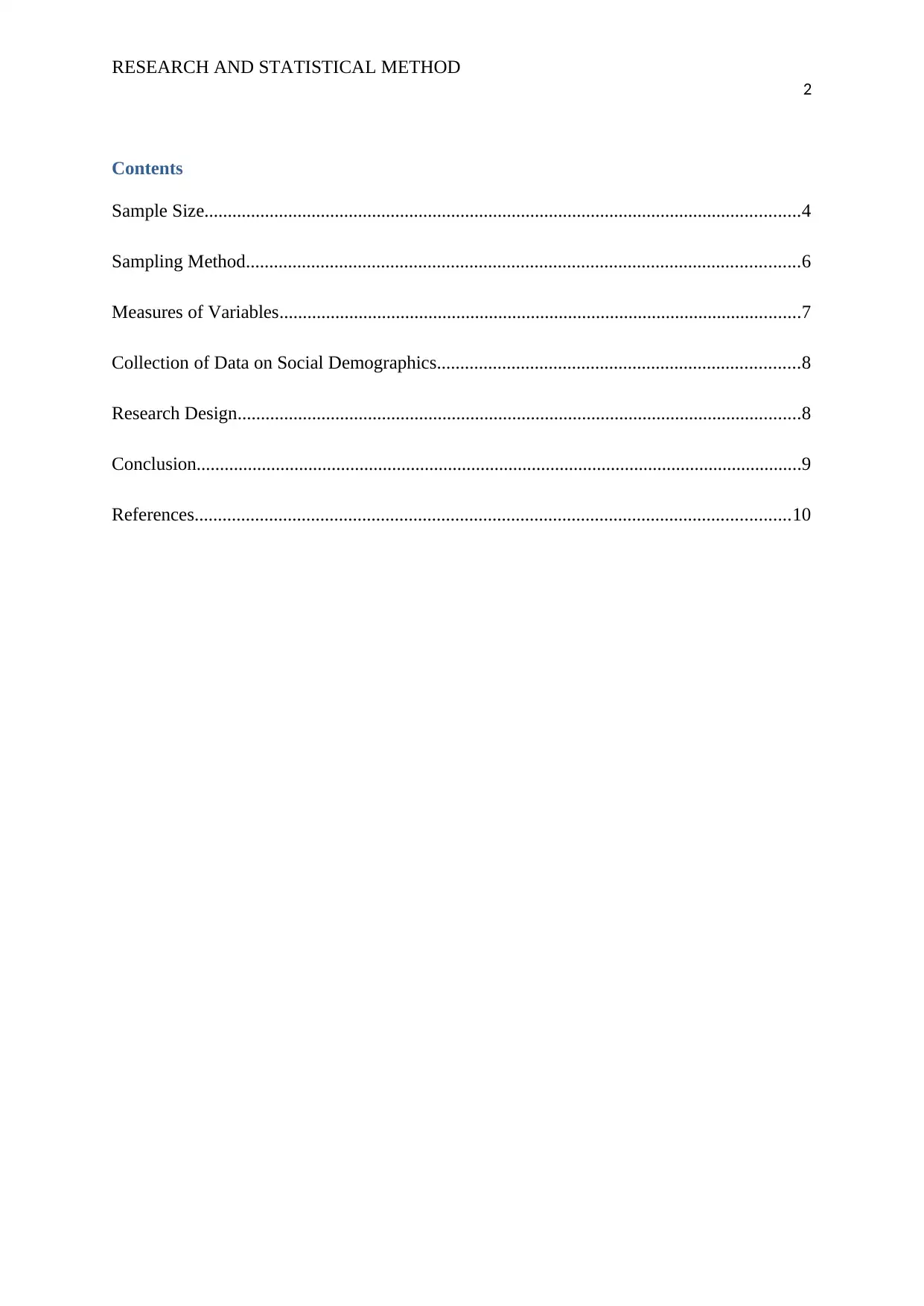
RESEARCH AND STATISTICAL METHOD
2
Contents
Sample Size................................................................................................................................4
Sampling Method.......................................................................................................................6
Measures of Variables................................................................................................................7
Collection of Data on Social Demographics..............................................................................8
Research Design.........................................................................................................................8
Conclusion..................................................................................................................................9
References................................................................................................................................10
2
Contents
Sample Size................................................................................................................................4
Sampling Method.......................................................................................................................6
Measures of Variables................................................................................................................7
Collection of Data on Social Demographics..............................................................................8
Research Design.........................................................................................................................8
Conclusion..................................................................................................................................9
References................................................................................................................................10

RESEARCH AND STATISTICAL METHOD
3
Research and Statistical Method for Business
Businesses need research and statistical methods to collect data, store, analyze and
interpret data to make informed management decisions. Research is typically conducted to
investigate hypothesis and establish truths about events (Hair, Wolfinbarger, Money,
Samouel, & Page, 2015). Many business models have been developed to inform research and
statistical methods of data collection and analysis including the “Research Onion” which is
used to describe the research method. The research onion was first created by Mark Saunders
in 2007 and later developed as a tool for formulating the research methodology (Saunders,
Lewis, & Thornhill, 2015).
Research in business is used to explain and analyze business events. The process of
research begins with planning, data collection, analysis, discussion, interpretation, and
recommendations for future reference. For optimal results, it is important to study a wide
range of variables including people, factors and their interaction (Hair, Wolfinbarger, Money,
Samouel, & Page, 2015). Appropriate research should be generalizable and replicable, and its
output should exceed the input. This paper answers questions on business research methods
with regarding a case study by De Witte, De Cuyper, Handaja, Sverke, Naswall, & Hellgren
(2010). De Witte and his team sought to understand the association between employee’s
perception of quantitative and qualitative job insecurity with job satisfaction, and
psychological distress in a cross-sectional survey of the Belgian banking sector.
Sample Size
Sample size refers to the representative sample of the general population (Spradley,
2016). Typically, a sample size of between 30 and 500 is acceptable but larger sample sizes
give more data for examination and analysis (Bryman & Bell, 2015). In this case study, the
sample size is 15,000 representing 21% of the total population which is 69,000. This sample
3
Research and Statistical Method for Business
Businesses need research and statistical methods to collect data, store, analyze and
interpret data to make informed management decisions. Research is typically conducted to
investigate hypothesis and establish truths about events (Hair, Wolfinbarger, Money,
Samouel, & Page, 2015). Many business models have been developed to inform research and
statistical methods of data collection and analysis including the “Research Onion” which is
used to describe the research method. The research onion was first created by Mark Saunders
in 2007 and later developed as a tool for formulating the research methodology (Saunders,
Lewis, & Thornhill, 2015).
Research in business is used to explain and analyze business events. The process of
research begins with planning, data collection, analysis, discussion, interpretation, and
recommendations for future reference. For optimal results, it is important to study a wide
range of variables including people, factors and their interaction (Hair, Wolfinbarger, Money,
Samouel, & Page, 2015). Appropriate research should be generalizable and replicable, and its
output should exceed the input. This paper answers questions on business research methods
with regarding a case study by De Witte, De Cuyper, Handaja, Sverke, Naswall, & Hellgren
(2010). De Witte and his team sought to understand the association between employee’s
perception of quantitative and qualitative job insecurity with job satisfaction, and
psychological distress in a cross-sectional survey of the Belgian banking sector.
Sample Size
Sample size refers to the representative sample of the general population (Spradley,
2016). Typically, a sample size of between 30 and 500 is acceptable but larger sample sizes
give more data for examination and analysis (Bryman & Bell, 2015). In this case study, the
sample size is 15,000 representing 21% of the total population which is 69,000. This sample
⊘ This is a preview!⊘
Do you want full access?
Subscribe today to unlock all pages.

Trusted by 1+ million students worldwide
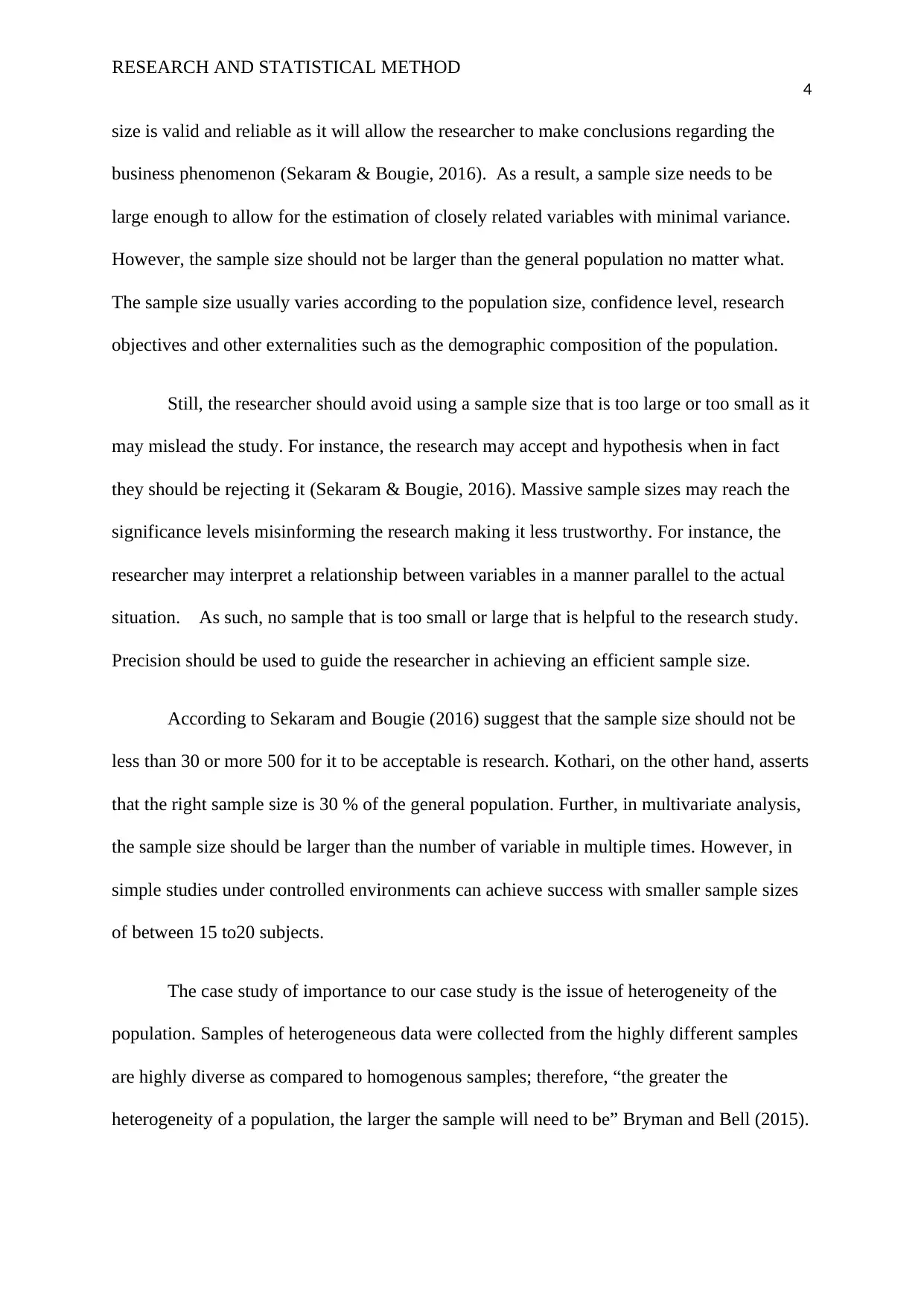
RESEARCH AND STATISTICAL METHOD
4
size is valid and reliable as it will allow the researcher to make conclusions regarding the
business phenomenon (Sekaram & Bougie, 2016). As a result, a sample size needs to be
large enough to allow for the estimation of closely related variables with minimal variance.
However, the sample size should not be larger than the general population no matter what.
The sample size usually varies according to the population size, confidence level, research
objectives and other externalities such as the demographic composition of the population.
Still, the researcher should avoid using a sample size that is too large or too small as it
may mislead the study. For instance, the research may accept and hypothesis when in fact
they should be rejecting it (Sekaram & Bougie, 2016). Massive sample sizes may reach the
significance levels misinforming the research making it less trustworthy. For instance, the
researcher may interpret a relationship between variables in a manner parallel to the actual
situation. As such, no sample that is too small or large that is helpful to the research study.
Precision should be used to guide the researcher in achieving an efficient sample size.
According to Sekaram and Bougie (2016) suggest that the sample size should not be
less than 30 or more 500 for it to be acceptable is research. Kothari, on the other hand, asserts
that the right sample size is 30 % of the general population. Further, in multivariate analysis,
the sample size should be larger than the number of variable in multiple times. However, in
simple studies under controlled environments can achieve success with smaller sample sizes
of between 15 to20 subjects.
The case study of importance to our case study is the issue of heterogeneity of the
population. Samples of heterogeneous data were collected from the highly different samples
are highly diverse as compared to homogenous samples; therefore, “the greater the
heterogeneity of a population, the larger the sample will need to be” Bryman and Bell (2015).
4
size is valid and reliable as it will allow the researcher to make conclusions regarding the
business phenomenon (Sekaram & Bougie, 2016). As a result, a sample size needs to be
large enough to allow for the estimation of closely related variables with minimal variance.
However, the sample size should not be larger than the general population no matter what.
The sample size usually varies according to the population size, confidence level, research
objectives and other externalities such as the demographic composition of the population.
Still, the researcher should avoid using a sample size that is too large or too small as it
may mislead the study. For instance, the research may accept and hypothesis when in fact
they should be rejecting it (Sekaram & Bougie, 2016). Massive sample sizes may reach the
significance levels misinforming the research making it less trustworthy. For instance, the
researcher may interpret a relationship between variables in a manner parallel to the actual
situation. As such, no sample that is too small or large that is helpful to the research study.
Precision should be used to guide the researcher in achieving an efficient sample size.
According to Sekaram and Bougie (2016) suggest that the sample size should not be
less than 30 or more 500 for it to be acceptable is research. Kothari, on the other hand, asserts
that the right sample size is 30 % of the general population. Further, in multivariate analysis,
the sample size should be larger than the number of variable in multiple times. However, in
simple studies under controlled environments can achieve success with smaller sample sizes
of between 15 to20 subjects.
The case study of importance to our case study is the issue of heterogeneity of the
population. Samples of heterogeneous data were collected from the highly different samples
are highly diverse as compared to homogenous samples; therefore, “the greater the
heterogeneity of a population, the larger the sample will need to be” Bryman and Bell (2015).
Paraphrase This Document
Need a fresh take? Get an instant paraphrase of this document with our AI Paraphraser
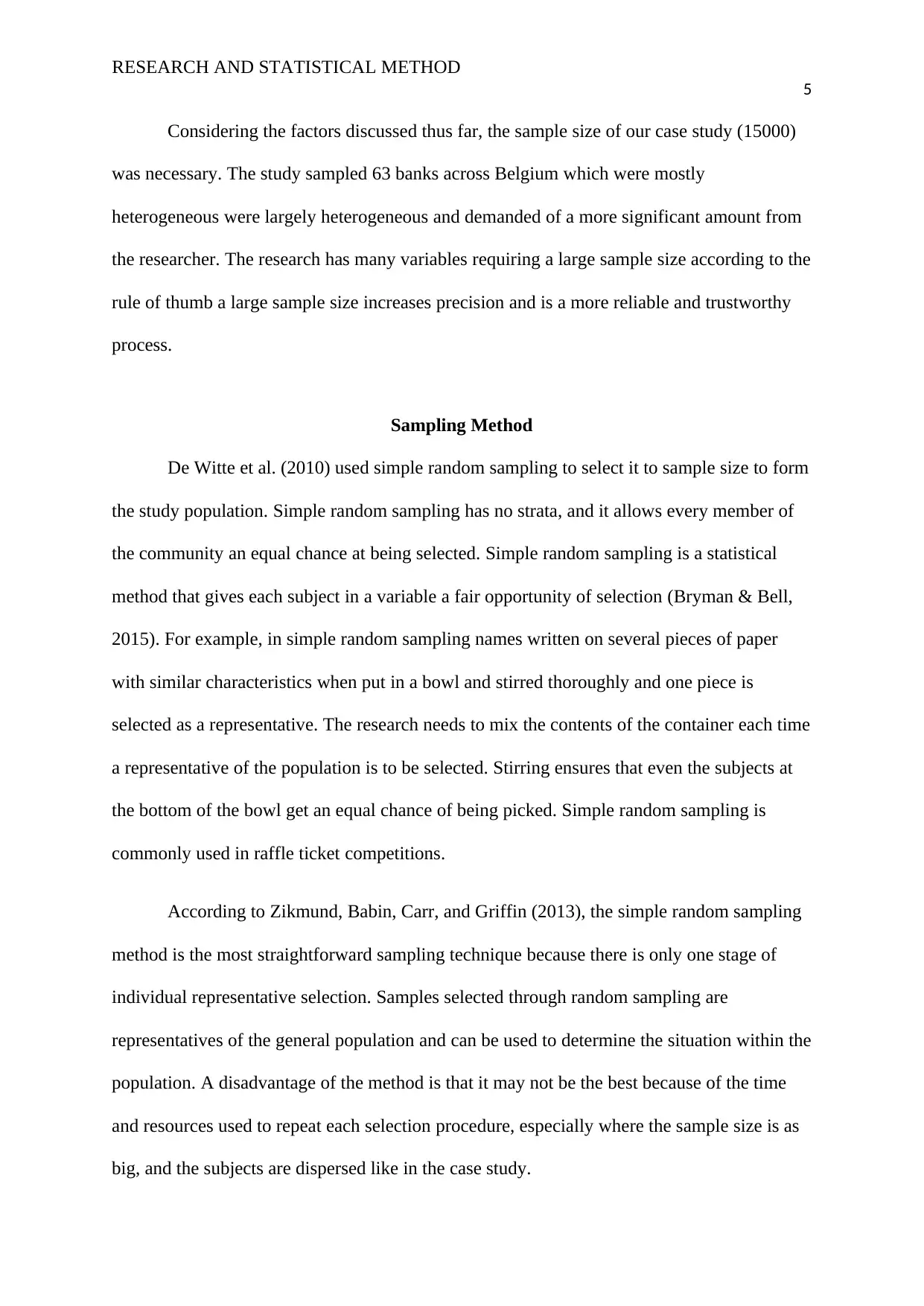
RESEARCH AND STATISTICAL METHOD
5
Considering the factors discussed thus far, the sample size of our case study (15000)
was necessary. The study sampled 63 banks across Belgium which were mostly
heterogeneous were largely heterogeneous and demanded of a more significant amount from
the researcher. The research has many variables requiring a large sample size according to the
rule of thumb a large sample size increases precision and is a more reliable and trustworthy
process.
Sampling Method
De Witte et al. (2010) used simple random sampling to select it to sample size to form
the study population. Simple random sampling has no strata, and it allows every member of
the community an equal chance at being selected. Simple random sampling is a statistical
method that gives each subject in a variable a fair opportunity of selection (Bryman & Bell,
2015). For example, in simple random sampling names written on several pieces of paper
with similar characteristics when put in a bowl and stirred thoroughly and one piece is
selected as a representative. The research needs to mix the contents of the container each time
a representative of the population is to be selected. Stirring ensures that even the subjects at
the bottom of the bowl get an equal chance of being picked. Simple random sampling is
commonly used in raffle ticket competitions.
According to Zikmund, Babin, Carr, and Griffin (2013), the simple random sampling
method is the most straightforward sampling technique because there is only one stage of
individual representative selection. Samples selected through random sampling are
representatives of the general population and can be used to determine the situation within the
population. A disadvantage of the method is that it may not be the best because of the time
and resources used to repeat each selection procedure, especially where the sample size is as
big, and the subjects are dispersed like in the case study.
5
Considering the factors discussed thus far, the sample size of our case study (15000)
was necessary. The study sampled 63 banks across Belgium which were mostly
heterogeneous were largely heterogeneous and demanded of a more significant amount from
the researcher. The research has many variables requiring a large sample size according to the
rule of thumb a large sample size increases precision and is a more reliable and trustworthy
process.
Sampling Method
De Witte et al. (2010) used simple random sampling to select it to sample size to form
the study population. Simple random sampling has no strata, and it allows every member of
the community an equal chance at being selected. Simple random sampling is a statistical
method that gives each subject in a variable a fair opportunity of selection (Bryman & Bell,
2015). For example, in simple random sampling names written on several pieces of paper
with similar characteristics when put in a bowl and stirred thoroughly and one piece is
selected as a representative. The research needs to mix the contents of the container each time
a representative of the population is to be selected. Stirring ensures that even the subjects at
the bottom of the bowl get an equal chance of being picked. Simple random sampling is
commonly used in raffle ticket competitions.
According to Zikmund, Babin, Carr, and Griffin (2013), the simple random sampling
method is the most straightforward sampling technique because there is only one stage of
individual representative selection. Samples selected through random sampling are
representatives of the general population and can be used to determine the situation within the
population. A disadvantage of the method is that it may not be the best because of the time
and resources used to repeat each selection procedure, especially where the sample size is as
big, and the subjects are dispersed like in the case study.
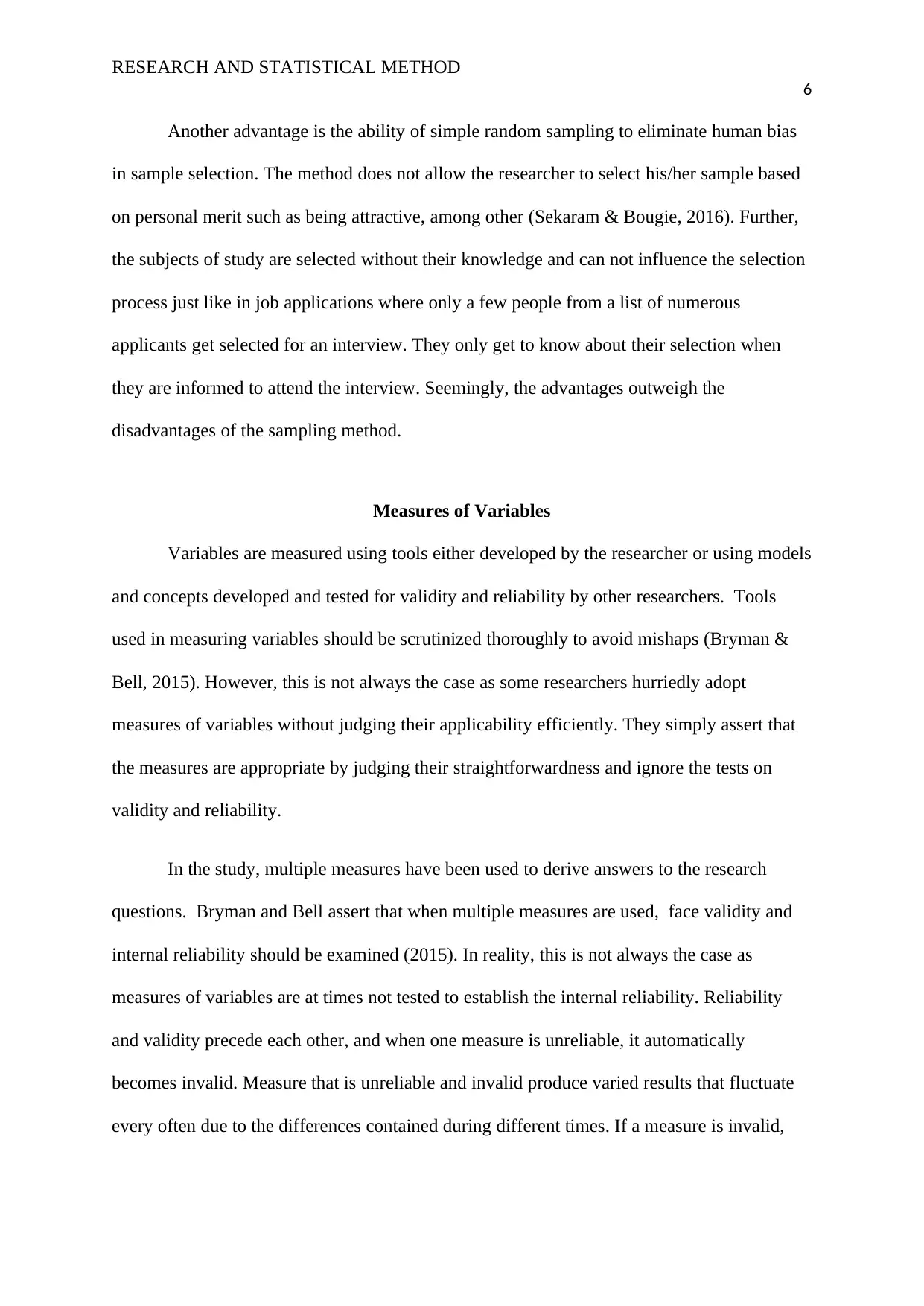
RESEARCH AND STATISTICAL METHOD
6
Another advantage is the ability of simple random sampling to eliminate human bias
in sample selection. The method does not allow the researcher to select his/her sample based
on personal merit such as being attractive, among other (Sekaram & Bougie, 2016). Further,
the subjects of study are selected without their knowledge and can not influence the selection
process just like in job applications where only a few people from a list of numerous
applicants get selected for an interview. They only get to know about their selection when
they are informed to attend the interview. Seemingly, the advantages outweigh the
disadvantages of the sampling method.
Measures of Variables
Variables are measured using tools either developed by the researcher or using models
and concepts developed and tested for validity and reliability by other researchers. Tools
used in measuring variables should be scrutinized thoroughly to avoid mishaps (Bryman &
Bell, 2015). However, this is not always the case as some researchers hurriedly adopt
measures of variables without judging their applicability efficiently. They simply assert that
the measures are appropriate by judging their straightforwardness and ignore the tests on
validity and reliability.
In the study, multiple measures have been used to derive answers to the research
questions. Bryman and Bell assert that when multiple measures are used, face validity and
internal reliability should be examined (2015). In reality, this is not always the case as
measures of variables are at times not tested to establish the internal reliability. Reliability
and validity precede each other, and when one measure is unreliable, it automatically
becomes invalid. Measure that is unreliable and invalid produce varied results that fluctuate
every often due to the differences contained during different times. If a measure is invalid,
6
Another advantage is the ability of simple random sampling to eliminate human bias
in sample selection. The method does not allow the researcher to select his/her sample based
on personal merit such as being attractive, among other (Sekaram & Bougie, 2016). Further,
the subjects of study are selected without their knowledge and can not influence the selection
process just like in job applications where only a few people from a list of numerous
applicants get selected for an interview. They only get to know about their selection when
they are informed to attend the interview. Seemingly, the advantages outweigh the
disadvantages of the sampling method.
Measures of Variables
Variables are measured using tools either developed by the researcher or using models
and concepts developed and tested for validity and reliability by other researchers. Tools
used in measuring variables should be scrutinized thoroughly to avoid mishaps (Bryman &
Bell, 2015). However, this is not always the case as some researchers hurriedly adopt
measures of variables without judging their applicability efficiently. They simply assert that
the measures are appropriate by judging their straightforwardness and ignore the tests on
validity and reliability.
In the study, multiple measures have been used to derive answers to the research
questions. Bryman and Bell assert that when multiple measures are used, face validity and
internal reliability should be examined (2015). In reality, this is not always the case as
measures of variables are at times not tested to establish the internal reliability. Reliability
and validity precede each other, and when one measure is unreliable, it automatically
becomes invalid. Measure that is unreliable and invalid produce varied results that fluctuate
every often due to the differences contained during different times. If a measure is invalid,
⊘ This is a preview!⊘
Do you want full access?
Subscribe today to unlock all pages.

Trusted by 1+ million students worldwide
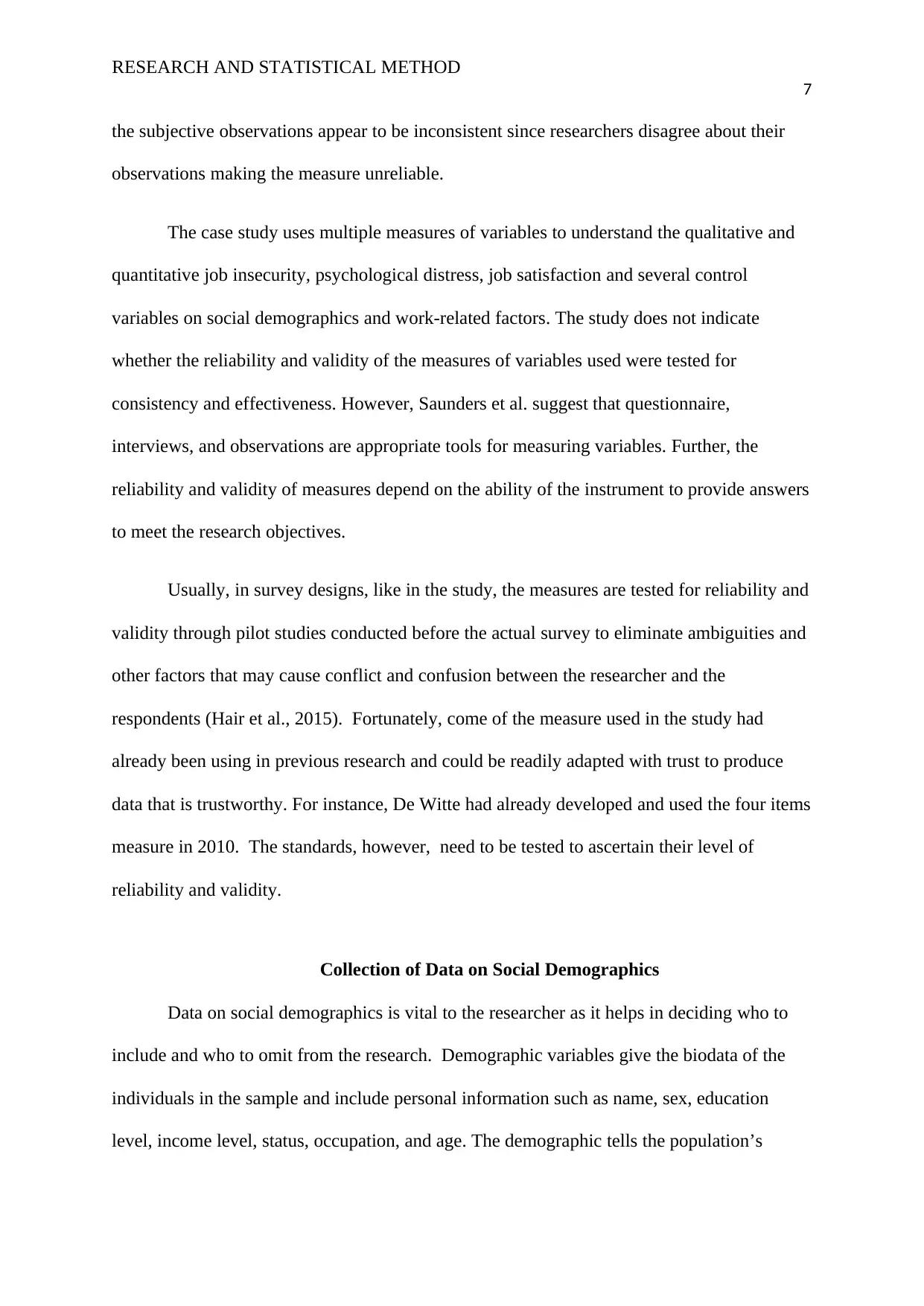
RESEARCH AND STATISTICAL METHOD
7
the subjective observations appear to be inconsistent since researchers disagree about their
observations making the measure unreliable.
The case study uses multiple measures of variables to understand the qualitative and
quantitative job insecurity, psychological distress, job satisfaction and several control
variables on social demographics and work-related factors. The study does not indicate
whether the reliability and validity of the measures of variables used were tested for
consistency and effectiveness. However, Saunders et al. suggest that questionnaire,
interviews, and observations are appropriate tools for measuring variables. Further, the
reliability and validity of measures depend on the ability of the instrument to provide answers
to meet the research objectives.
Usually, in survey designs, like in the study, the measures are tested for reliability and
validity through pilot studies conducted before the actual survey to eliminate ambiguities and
other factors that may cause conflict and confusion between the researcher and the
respondents (Hair et al., 2015). Fortunately, come of the measure used in the study had
already been using in previous research and could be readily adapted with trust to produce
data that is trustworthy. For instance, De Witte had already developed and used the four items
measure in 2010. The standards, however, need to be tested to ascertain their level of
reliability and validity.
Collection of Data on Social Demographics
Data on social demographics is vital to the researcher as it helps in deciding who to
include and who to omit from the research. Demographic variables give the biodata of the
individuals in the sample and include personal information such as name, sex, education
level, income level, status, occupation, and age. The demographic tells the population’s
7
the subjective observations appear to be inconsistent since researchers disagree about their
observations making the measure unreliable.
The case study uses multiple measures of variables to understand the qualitative and
quantitative job insecurity, psychological distress, job satisfaction and several control
variables on social demographics and work-related factors. The study does not indicate
whether the reliability and validity of the measures of variables used were tested for
consistency and effectiveness. However, Saunders et al. suggest that questionnaire,
interviews, and observations are appropriate tools for measuring variables. Further, the
reliability and validity of measures depend on the ability of the instrument to provide answers
to meet the research objectives.
Usually, in survey designs, like in the study, the measures are tested for reliability and
validity through pilot studies conducted before the actual survey to eliminate ambiguities and
other factors that may cause conflict and confusion between the researcher and the
respondents (Hair et al., 2015). Fortunately, come of the measure used in the study had
already been using in previous research and could be readily adapted with trust to produce
data that is trustworthy. For instance, De Witte had already developed and used the four items
measure in 2010. The standards, however, need to be tested to ascertain their level of
reliability and validity.
Collection of Data on Social Demographics
Data on social demographics is vital to the researcher as it helps in deciding who to
include and who to omit from the research. Demographic variables give the biodata of the
individuals in the sample and include personal information such as name, sex, education
level, income level, status, occupation, and age. The demographic tells the population’s
Paraphrase This Document
Need a fresh take? Get an instant paraphrase of this document with our AI Paraphraser
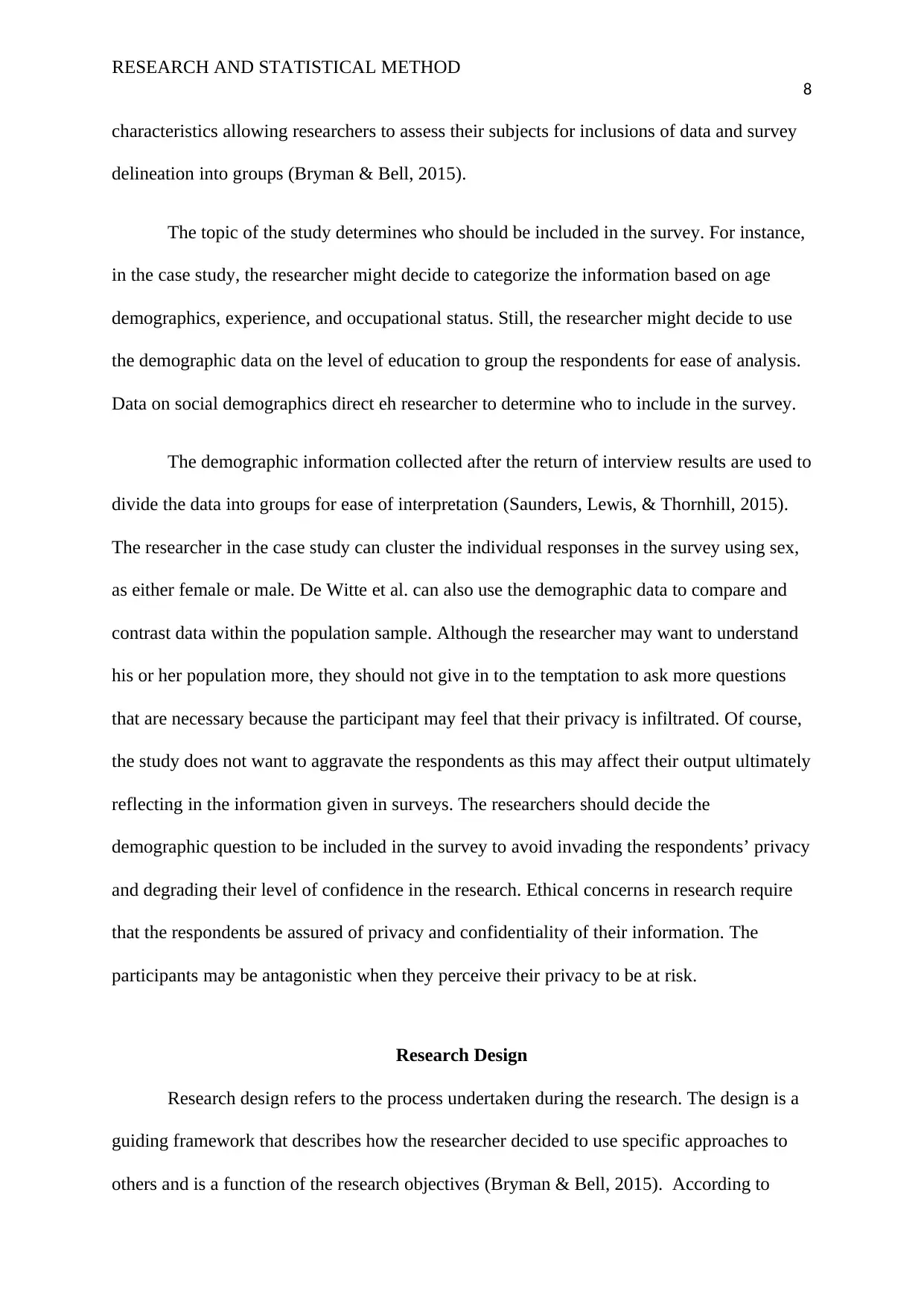
RESEARCH AND STATISTICAL METHOD
8
characteristics allowing researchers to assess their subjects for inclusions of data and survey
delineation into groups (Bryman & Bell, 2015).
The topic of the study determines who should be included in the survey. For instance,
in the case study, the researcher might decide to categorize the information based on age
demographics, experience, and occupational status. Still, the researcher might decide to use
the demographic data on the level of education to group the respondents for ease of analysis.
Data on social demographics direct eh researcher to determine who to include in the survey.
The demographic information collected after the return of interview results are used to
divide the data into groups for ease of interpretation (Saunders, Lewis, & Thornhill, 2015).
The researcher in the case study can cluster the individual responses in the survey using sex,
as either female or male. De Witte et al. can also use the demographic data to compare and
contrast data within the population sample. Although the researcher may want to understand
his or her population more, they should not give in to the temptation to ask more questions
that are necessary because the participant may feel that their privacy is infiltrated. Of course,
the study does not want to aggravate the respondents as this may affect their output ultimately
reflecting in the information given in surveys. The researchers should decide the
demographic question to be included in the survey to avoid invading the respondents’ privacy
and degrading their level of confidence in the research. Ethical concerns in research require
that the respondents be assured of privacy and confidentiality of their information. The
participants may be antagonistic when they perceive their privacy to be at risk.
Research Design
Research design refers to the process undertaken during the research. The design is a
guiding framework that describes how the researcher decided to use specific approaches to
others and is a function of the research objectives (Bryman & Bell, 2015). According to
8
characteristics allowing researchers to assess their subjects for inclusions of data and survey
delineation into groups (Bryman & Bell, 2015).
The topic of the study determines who should be included in the survey. For instance,
in the case study, the researcher might decide to categorize the information based on age
demographics, experience, and occupational status. Still, the researcher might decide to use
the demographic data on the level of education to group the respondents for ease of analysis.
Data on social demographics direct eh researcher to determine who to include in the survey.
The demographic information collected after the return of interview results are used to
divide the data into groups for ease of interpretation (Saunders, Lewis, & Thornhill, 2015).
The researcher in the case study can cluster the individual responses in the survey using sex,
as either female or male. De Witte et al. can also use the demographic data to compare and
contrast data within the population sample. Although the researcher may want to understand
his or her population more, they should not give in to the temptation to ask more questions
that are necessary because the participant may feel that their privacy is infiltrated. Of course,
the study does not want to aggravate the respondents as this may affect their output ultimately
reflecting in the information given in surveys. The researchers should decide the
demographic question to be included in the survey to avoid invading the respondents’ privacy
and degrading their level of confidence in the research. Ethical concerns in research require
that the respondents be assured of privacy and confidentiality of their information. The
participants may be antagonistic when they perceive their privacy to be at risk.
Research Design
Research design refers to the process undertaken during the research. The design is a
guiding framework that describes how the researcher decided to use specific approaches to
others and is a function of the research objectives (Bryman & Bell, 2015). According to
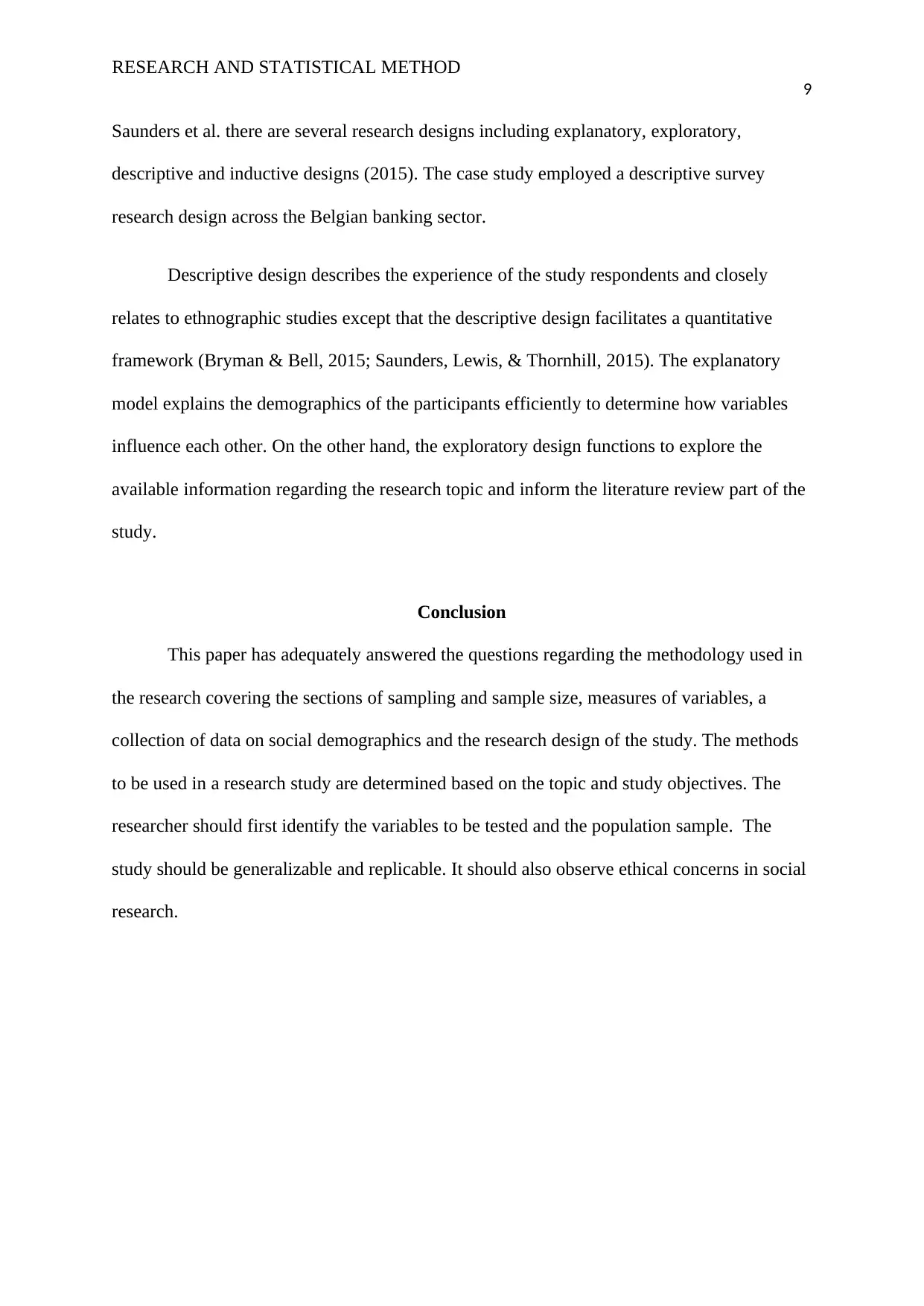
RESEARCH AND STATISTICAL METHOD
9
Saunders et al. there are several research designs including explanatory, exploratory,
descriptive and inductive designs (2015). The case study employed a descriptive survey
research design across the Belgian banking sector.
Descriptive design describes the experience of the study respondents and closely
relates to ethnographic studies except that the descriptive design facilitates a quantitative
framework (Bryman & Bell, 2015; Saunders, Lewis, & Thornhill, 2015). The explanatory
model explains the demographics of the participants efficiently to determine how variables
influence each other. On the other hand, the exploratory design functions to explore the
available information regarding the research topic and inform the literature review part of the
study.
Conclusion
This paper has adequately answered the questions regarding the methodology used in
the research covering the sections of sampling and sample size, measures of variables, a
collection of data on social demographics and the research design of the study. The methods
to be used in a research study are determined based on the topic and study objectives. The
researcher should first identify the variables to be tested and the population sample. The
study should be generalizable and replicable. It should also observe ethical concerns in social
research.
9
Saunders et al. there are several research designs including explanatory, exploratory,
descriptive and inductive designs (2015). The case study employed a descriptive survey
research design across the Belgian banking sector.
Descriptive design describes the experience of the study respondents and closely
relates to ethnographic studies except that the descriptive design facilitates a quantitative
framework (Bryman & Bell, 2015; Saunders, Lewis, & Thornhill, 2015). The explanatory
model explains the demographics of the participants efficiently to determine how variables
influence each other. On the other hand, the exploratory design functions to explore the
available information regarding the research topic and inform the literature review part of the
study.
Conclusion
This paper has adequately answered the questions regarding the methodology used in
the research covering the sections of sampling and sample size, measures of variables, a
collection of data on social demographics and the research design of the study. The methods
to be used in a research study are determined based on the topic and study objectives. The
researcher should first identify the variables to be tested and the population sample. The
study should be generalizable and replicable. It should also observe ethical concerns in social
research.
⊘ This is a preview!⊘
Do you want full access?
Subscribe today to unlock all pages.

Trusted by 1+ million students worldwide
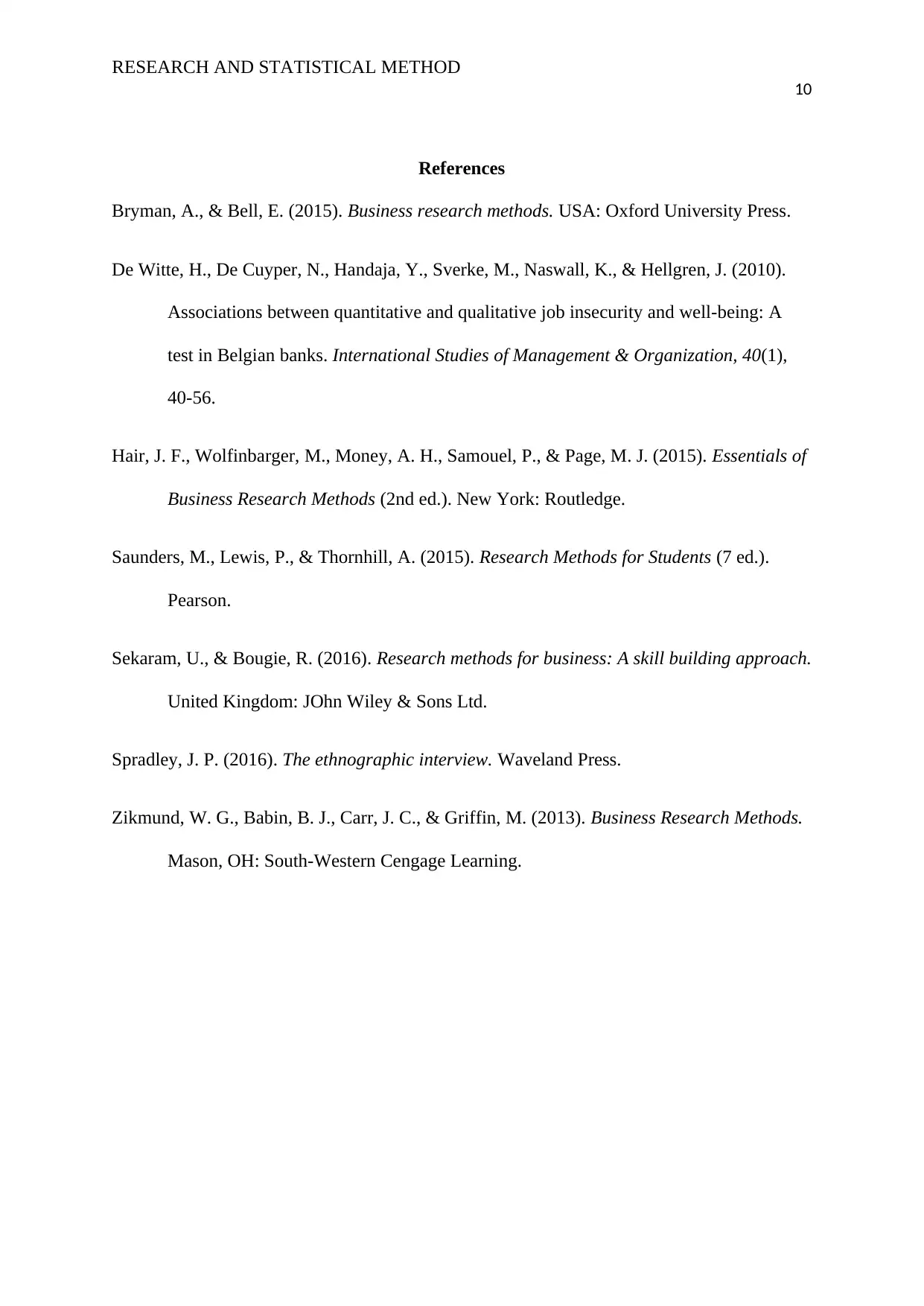
RESEARCH AND STATISTICAL METHOD
10
References
Bryman, A., & Bell, E. (2015). Business research methods. USA: Oxford University Press.
De Witte, H., De Cuyper, N., Handaja, Y., Sverke, M., Naswall, K., & Hellgren, J. (2010).
Associations between quantitative and qualitative job insecurity and well-being: A
test in Belgian banks. International Studies of Management & Organization, 40(1),
40-56.
Hair, J. F., Wolfinbarger, M., Money, A. H., Samouel, P., & Page, M. J. (2015). Essentials of
Business Research Methods (2nd ed.). New York: Routledge.
Saunders, M., Lewis, P., & Thornhill, A. (2015). Research Methods for Students (7 ed.).
Pearson.
Sekaram, U., & Bougie, R. (2016). Research methods for business: A skill building approach.
United Kingdom: JOhn Wiley & Sons Ltd.
Spradley, J. P. (2016). The ethnographic interview. Waveland Press.
Zikmund, W. G., Babin, B. J., Carr, J. C., & Griffin, M. (2013). Business Research Methods.
Mason, OH: South-Western Cengage Learning.
10
References
Bryman, A., & Bell, E. (2015). Business research methods. USA: Oxford University Press.
De Witte, H., De Cuyper, N., Handaja, Y., Sverke, M., Naswall, K., & Hellgren, J. (2010).
Associations between quantitative and qualitative job insecurity and well-being: A
test in Belgian banks. International Studies of Management & Organization, 40(1),
40-56.
Hair, J. F., Wolfinbarger, M., Money, A. H., Samouel, P., & Page, M. J. (2015). Essentials of
Business Research Methods (2nd ed.). New York: Routledge.
Saunders, M., Lewis, P., & Thornhill, A. (2015). Research Methods for Students (7 ed.).
Pearson.
Sekaram, U., & Bougie, R. (2016). Research methods for business: A skill building approach.
United Kingdom: JOhn Wiley & Sons Ltd.
Spradley, J. P. (2016). The ethnographic interview. Waveland Press.
Zikmund, W. G., Babin, B. J., Carr, J. C., & Griffin, M. (2013). Business Research Methods.
Mason, OH: South-Western Cengage Learning.
1 out of 10
Related Documents
Your All-in-One AI-Powered Toolkit for Academic Success.
+13062052269
info@desklib.com
Available 24*7 on WhatsApp / Email
![[object Object]](/_next/static/media/star-bottom.7253800d.svg)
Unlock your academic potential
Copyright © 2020–2025 A2Z Services. All Rights Reserved. Developed and managed by ZUCOL.





